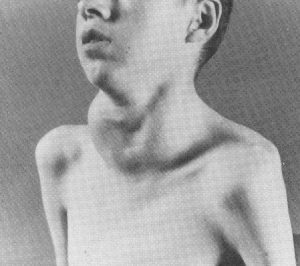Endocrine
See also Topic on Steroids and Anti-inflammatories
Thyroid function, iodide therapy, growth hormone
1960 Ruben BL, Crigler JF Jr, Berenberg W, Shwachman H. Hypothyroidism: a complication of iodide therapy in children with chronic respiratory involvement of cystic fibrosis. Am J Dis Child 1960; 100:721-722.
This report is of two children with CF who developed hypothyroidism whilst taking iodide therapy to improve sputum clearance – in these two patients there was no thyroid enlargement. Later Dolan TF & Gibson LE (J Pediatr 1971; 79:684-687. below) reported 55 patients on long-term iodide therapy of whom a remarkable 85% developed goitres and also 24% had evidence of hypothyroidism. Their thyroid glands were enlarged, sometimes markedly so, usually after three years or so of iodide therapy. There was discussion as to the possibility of an intrinsic defect of thyroid function but people with CF not taking iodides were all euthyroid.
1971 Dolan TF, Gibson LE. Complications of iodide therapy in patients with cystic fibrosis. J Pediatr 1971; 79:684-687. [PubMed]
Iodides had been used for asthma from the 19th century and were reported to have the effect in asthmatics that the “morning cough was of much shorter duration, say 5 minutes instead of 60 minutes, and that the phlegm was now loose” (Bernecker C. Intermittent therapy with potassium iodide in chronic obstructive disease of the airways. Acta Allergol 1969; XXIV:216-225.[PubMed]). In the present study from Yale 47 of 55 patients with CF who were on long term iodides to aid expectoration developed goitres usually within two to three years; also 14 had laboratory evidence of hypothyroidism. Two patients with CF had goitres but were not taking iodides. The rather limited evidence for the efficacy of iodides was reviewed – there were no studies showing improvement in respiratory function.
The authors indicated their intention to discontinue iodide therapy and they planned to evaluate the effect of iodides in a future study (also Ruben et al, 1960 above; Vagenakis et al, 1975 below).
1975 Vagenakis AG, Braverman LE. Adverse effects of iodides on thyroid function. Med Clin N Am 1975; 59:1075-1088. [PubMed]
The administration of pharmacologic quantities of iodine as iodides for the treatment of pulmonary disease may result in goitre, hypothyroidism, or hyperthyroidism, especially in patients with underlying thyroid disease. The aetiology of iodide-induced goiter and hypothyroidism in patients with cystic fibrosis treated with iodides was unclear.

Large goitre from iodide expectorants
– The use of iodides to reduce sputum viscosity was common practice and is mentioned by a number of authors including Shwachman who mentioned their use as helpful in a number of his review articles. In a subsequent report from Shwachman and colleagues (Segall-Blank, M et al, Thyroid gland function and pituitary TSH reserve in patients with cystic fibrosis. J Pediatr 1981; 98:218-222. [PubMed]) they state that, in view of the reported enhanced sensitivity to iodide-induced hypothyroidism in patients with cystic fibrosis, studies were carried out to determine the possible mechanism of this abnormality. But their findings did not delineate the mechanism whereby patients with CF develop iodide-induced hypothyroidism (also Ruben et al, 1960 above; Dolan & Gibson, 1971).
2005 Volta C, Street M, Ziveri MA, Bonelli P, Spaggiari C, Grzincich GL, Bernasconi S. Thyroid functiio, cytokine and IGF-IGFBP interactions in cystic fibrosis patients. Horm Res 2005: 63:206-210.[PubMed]
Seventeen young adult CF patients and 18 age-matched controls were enrolled in this study. The diagnosis of CF was confirmed by genetic analysis. None was treated with pulmonary expectorants. Serum IL-1beta, IL-6, TNF-alpha, IGF-I, IGF-II, IGFBP-2, IGFBP-3, TSH, fT3 and fT4 were measured using standard commercial kits. TSH, fT3 and fT4 serum levels were similar in CF patients and controls. Within the patient group, thyroid function did not vary in relation to C-reactive protein serum levels, respiratory function and clinical conditions (Shwachman score). No correlation was found with any growth factor or cytokine analysed.
These results were at variance with the few previously published data, and did not detect any difference in thyroid function in patients with CF compared with normal healthy subjects. This could be due to the fact that no iodine overload or selenite deficiency was present in these patients. Thyroid function seemed independent of markers of inflammation and IGF-IGFBP serum levels.
– A reassuring study showing these young adults with CF had normal thyroid function.
2010 Li H, Ganta S, Fong P. Altered ion transport by thyroid epithelia from CFTR(-/-) pigs suggests mechanisms for hypothyroidism in cystic fibrosis. Exper Physiol 2010; 95:1132-1144. [PubMed] Free PMC article.
Subclinical hypothyroidism has been linked to cystic fibrosis, and the cystic fibrosis transmembrane conductance regulator (CFTR) shown to be expressed in the thyroid. The thyroid epithelium secretes Cl- and absorbs Na(+) in response to cAMP. These studies definitively demonstrate that CFTR mediates cAMP-stimulated Cl- secretion in a well-differentiated thyroid culture model and that knockout of CFTR promotes increased Na(+) absorption by a mechanism other than increased ENaC expression. These findings suggest several models for the mechanism of cystic fibrosis-associated hypothyroidism. Suggest see the full abstract for details.
– There have been a number of publications on the relationship between CF and hypothyroidism in the older literature. (Vagenakis, A G et al, Med Clin N Am 1975; 59:1075-1088.). The use of iodides to reduce sputum viscosity was common practice in the past and is mentioned by a number of authors including Harry Shwachman who mentioned their use as helpful in a number of his review articles. In a subsequent report from Shwachman and colleagues (Segall-Blank, M et al, Thyroid gland function and pituitary TSH reserve in patients with cystic fibrosis. J Pediatr 1981; 98:218-222.[PubMed]) they state that, in view of the reported enhanced sensitivity to iodide-induced hypothyroidism in patients with cystic fibrosis, studies were carried out to determine the possible mechanism of this abnormality. But their findings did not delineate the mechanism whereby patients with CF develop iodide-induced hypothyroidism (also see Ruben et al, 1960 above; Dolan & Gibson, 1971 above). The present studies reported here seem to throw some light on the subject.
2013 Naehrlich L, Dorr HG, Bagheri-Behrouzi A, Rauh M. Iodine deficiency and subclinical hypothyroidism are common in cystic fibrosis patients. J Trace Elem Med Bio 2013; 27:122-125.[PubMed]
Disorders of thyroid function have been inconsistently described in cystic fibrosis patients and in CF animals but the literature lacks reports on iodine status of CF individuals. The authors hypothesized that iodine deficiency is common in CF and accounts for abnormal thyroid function in CF patients. So they investigated 129 children, adolescents, and adults with CF, who were living in the northern part of Bavaria/Germany. Malnutrition and lung function were analyzed. Urinary iodine excretion, TSH (thyroid-stimulating hormone), and ft4 (free thyroxine) were measured and set in relation to population-based, age-adjusted reference ranges. Subclinical hypothyroidism (normal fT4, elevated TSH) was found in 11.6% of subjects, and iodine deficiency in 83.7%. No correlations were found with age, BMI, status of malnutrition, or lung function.
The authors concluded that there was dramatic iodine deficiency in their cohort of CF patients and this condition can cause subclinical hypothyroidism; they therefore advise an individual iodine supplementation program is necessary and should be started immediately.
– Thyroid function and iodine status in CF have been the subject of many publications over the years. Some have failed to detect any abnormality of thyroid function (Volta C et al. Horm Res 2005: 63:206-210.[PubMed]) attributing previous findings possibly to the presence of associated selenium deficiency or iodine overload in the CF patients. Over 50 years ago hypothyroidism was described in two patients as a complication of iodide therapy, used to treat the respiratory condition in CF (Ruben BL et al. Am J Dis Child 1960; 100:721-722. Details in “Topics- Endocrine”). Later Dolan TF & Gibson LE (J Pediatr 1971; 79:684-687. Details in Topics – Endocrine) reported 55 patients on long-term iodide therapy of whom a remarkable 85% developed goitres and also 24% had evidence of hypothyroidism. Their thyroid glands were enlarged, sometimes markedly so, usually after three years or so of iodide therapy. There was discussion as to the possibility of an intrinsic defect of thyroid function but people with CF not taking iodides were all euthyroid. Also the findings of Volta et al, 2005 (above) are reassuring suggesting perhaps the recent advice of Naerhrlich et al. 2013 is not generally applicable.
Blackman SM; Tangpricha V. Endocrine disorders in cystic fibrosis. Pediatric Clinics of North America. 63(4):699-708, 2016 Aug. [PubMed]

Scott Blakeman
Cystic fibrosis is frequently complicated by endocrine disorders. Diabetes can be expected to affect most with CF and pancreatic insufficiency and varies widely in age of onset, but early identification and treatment improve morbidity and mortality. Short stature can be exacerbated by relative delay of puberty and by use of inhaled corticosteroids. Bone disease in CF causes fragility fractures and should be assessed by monitoring bone mineral density and optimizing vitamin D status. Detecting and managing endocrine complications in CF can reduce morbidity and mortality in CF. These complications can be expected to become more common as the CF population ages.
Scott Michael Blackman (figure) is Associate Professor of Pediatrics at Johns Hopkins, Baltimore. To improve the clinical care for people with endocrine complications of CF, he started a multidisciplinary clinic for paediatric patients with CF and cystic fibrosis-related diabetes.
Growth hormone
2001 Hardin DS, Ellis KJ, Dyson M, Rice J, McConnell R, Seilheimer DK. Growth hormone improves clinical status in prepubertal children with cystic fibrosis: results of a randomized controlled trial. J Pediatr 2001; 139:636-642. [PubMed]

Dana Hardin
Nine children with CF treated with growth hormone had significantly greater height, height velocity, weight, weight velocity and change in lean tissue mass. Also the treated group had significant improvement in forced vital capacity compared with the year before the study, and respiratory muscle strength improved. The number of hospitalizations and outpatient intravenous antibiotic courses significantly decreased in the treated group but did not change in the control group. Results of this before and after study of GH treatment in cystic fibrosis suggested that GH improves growth and clinical status.
There was a later controlled trial by Hardin HS et al. 2006 (below). Also Schnabel D et al. 2007 (below) from Germany. However, most centres do not use and would be unlikely to use growth hormone to treat children with CF; its role is still not entirely clear particularly as the nutritional state of children with CF improves with better treatment.
2004 Hardin DS. GH improves growth and clinical status in children with cystic fibrosis — a review of published studies. [Review] Eur J Endocrinol 2004; 151 Suppl 1:S81-85. [PubMed]
The purpose of this article is to summarize studies evaluating GH use in children with CF. All published studies of GH use in children with CF have demonstrated significant improvement in height velocity and height Z score. All studies but one, in which subjects were treated only three times per week with GH, have demonstrated improvement in weight as reported by weight velocity and/or weight Z score, and one trial has demonstrated a substantial improvement when GH was used to augment nutritional therapy. Several reports suggest that GH treatment results in improved forced vital capacity, and multiple studies have found improved clinical status as measured by decreased hospitalizations and courses of intravenous antibiotics. Furthermore studies to date also suggest that GH results in improvement in exercise tolerance and bone accumulation. To date significant side effects, including glucose intolerance, have not been reported. Thus mounting evidence suggests that human recombinant GH provides safe and effective therapy in children with CF.
Hardin has published a previous study on human growth hormone in CF (Hardin et al. 2001) [PubMed]) and also a more recent study([PubMed]).
2005 Hardin DS, Ferkol T, Ahn C, Dreimane D, Dyson M, Morse M, Prestidge C, Rice J, Seilheimer DK. A retrospective study of growth hormone use in adolescents with cystic fibrosis. Clin Endocrinol 2005; 62:560-566. [PubMed]
The results of this study suggest that growth hormone use in pubertal adolescents with CF safely improves height, body weight, bone mineralization and clinical status. Hardin and colleagues have published a number of previous studies on the use of growth hormone in CF.
2006 Hardin DS, Adams-Huet B, Brown D, Chatfield B, Dyson M, Ferkol T, Howenstine M, Prestidge C, Royce F, Rice J, Seilheimer DK, Steelman J, Shepherds R. Growth hormone treatment improves growth and clinical status in prepubertal children with cystic fibrosis: results of a multicenter randomized controlled trial. J Clin Endocrin Metab 2006; 91:4925-9. [PubMed]
Sixty one prepubertal children were either treated with growth hormone or were controls. After 1 yr, growth hormone treated children had significantly greater gain in height, weight, lean body mass, and bone mineral content. They had fewer hospitalizations and an improvement in CF quality of life but there was no difference in pulmonary function between groups. After cessation of GH treatment, there was a sustained effect for increased height and weight velocity, as well as accrual of bone mineral.
Although there was a significant favourable effect for the growth hormone treatment there are few children who receive or indeed now require this treatment (also Hardin et al, 2001 above). [PubMed]
2007 Schnabel D, Grasemann C, Staab D, Wollmann H, Ratjen F. German Cystic Fibrosis Growth Hormone Study Group. A multicenter, randomized, double-blind, placebo-controlled trial to evaluate the metabolic and respiratory effects of growth hormone in children with cystic fibrosis. Pediatrics 2007; 119:e1230-1238. [PubMed]
Another multicenter, randomized, placebo-controlled, double-blind study to assess the efficacy and safety of 2 dosages of growth hormone in cystic fibrosis. Sixty-three dystrophic patients with cystic fibrosis were randomly assigned for 24 weeks to 1 of 3 treatment arms followed by an open treatment period of 24 weeks. Height, growth velocity, and growth factors increased significantly in both treatment groups, whereas weight gain did not differ between the growth hormone groups and placebo. Maximal oxygen uptake during peak exercise increased significantly in treated patients.
The authors concluded that these data suggest that in the group investigated, growth hormone therapy was well tolerated and had positive metabolic effects but did not result in short-term improvement of lung function in patients with cystic fibrosis
– It is unlikely that many CF clinicians would advise growth hormone therapy except perhaps in exceptional circumstances; also it is hoped that with present day treatment there will be fewer “dystrophic” children who would benefit from this form of treatment which involves daily subcutaneous injections and costs up to £15K per year (also Hardin et al, 2001 above; Hardin et al, 2006 above).
2009 Switzer M, Rice J, Rice M, Hardin DS. Insulin-like growth factor-I levels predict weight, height and protein catabolism in children and adolescents with cystic fibrosis. J Pediatr Endocrinol 2009; 22:417-424.[PubMed]
There was also a strong relationship between leucine rate of appearance (a measure of protein catabolism) and IGF-I. These results suggest a strong correlation between IGF-I and height, weight and protein catabolism and emphasize the need to normalize IGF-I levels in children with cystic fibrosis.
– Dana Hardin has written a number of papers on the use of growth hormone. Here they analyze the IGF-1 levels in the patients studied previously studied. It is interesting that in recent animal studies involving CF pigs there seems to be a relationship between IGF-1 and the growth potential of the animals (Rogan MP et al. 2010.[PubMed]).
2010 Rogan MP, Reznikov LR, Pezzulo AA, Gansemer ND, Samuel M, Prather RS, Zabner J, Fredericks DC, McCray PB Jr, Welsh MJ, Stoltz DA. Pigs and humans with cystic fibrosis have reduced insulin-like growth factor 1 (IGF1) levels at birth. Proc Nat Acad Sci 2010; 107:20571-5. [PubMed]
People with cystic fibrosis (CF) exhibit growth defects. That observation has been attributed, in part, to decreased insulin-like growth factor 1 (IGF1) levels, and the reduction has been attributed to malnutrition and pulmonary inflammation. However, patients with CF already have a reduced weight at birth, a manifestation not likely to be secondary to poor intrauterine nutrition or inflammation. Also CF pigs were smaller than their non-CF littermates and had lower IGF1 levels. To better understand the basis of IGF1 reduction, the authors studied newborn CF pigs and found low IGF1 levels within 12 hours of birth. Moreover, humerus length and bone mineral content were decreased, consistent with less IGF1 activity in utero. These findings led them to test newborn humans with CF, and they found that they also had reduced IGF1 levels. Discovering lower IGF1 levels in newborn pigs and humans indicates that the decrease is not solely a consequence of malnutrition or pulmonary inflammation and that loss of cystic fibrosis transmembrane conductance regulator function has a more direct effect. Consistent with this hypothesis, they discovered reduced growth hormone release in organotypic pituitary slice cultures of newborn CF pigs. These findings may explain the long-standing observation that CF newborns are smaller than non-CF babies and why some patients with good clinical status fail to reach their growth potential. The results also suggest that measuring IGF1 levels might be of value as a biomarker to predict disease severity or the response to therapeutics. Finally, they raise the possibility that IGF1 supplementation beginning in infancy might be beneficial in CF.
– These very interesting findings do explain the suboptimal growth of some CF infants despite optimal treatment and a good clinical condition. Also they provide a very plausible explanation for the well documented reduced birth weight of CF infants as a group. Various studies (reviewed above) have shown that growth hormone has some value in improving growth of CF children but as yet IGF-1 supplementation has not been reported although the relationship of growth and IGF-1 has been described in CF (2009 Switzer M. Rice J. Rice M. Hardin DS. Insulin-like growth factor-I levels predict weight, height and protein catabolism in children and adolescents with cystic fibrosis. J Pediatr Endocrinol 2009; 22:417-424.[PubMed]
2011 Haupt ME, Kim EE, Prestridge AL. Successful prolonged use of recombinant human insulin-like growth factor-1 in a child with cystic fibrosis. Pediatr Pulmonol 2011; 46:1137-41. [PubMed]
These authors report the successful prolonged use of recombinant human insulin-like growth factor-1 in an adolescent boy with CF, who demonstrated significant clinical benefits from the therapy.
– Growth failure is a common and complicated process in children with cystic fibrosis. Growth hormone, which is becoming a more commonly used agent in such patients, has demonstrated beneficial effects aside from increased growth velocity. Recently, insulin-like growth factor-1 has gained significant attention in the understanding of growth failure in children with CF. This present report is the first of its use in a child with CF
2012 Stalvey MS, Anbar RD, Konstan MW, Jacobs JR, Bakker B, Lippe B, Geller DE. A multi-center controlled trial of growth hormone treatment in children with cystic fibrosis. Pediatr Pulmonol 2012; 47:252-263. [PubMed]
A multicenter, open-label, controlled clinical trial comparing outcomes in prepubertal children <14 years with CF, randomized in a 1:1 ratio to receive daily rhGH (Nutropin AQ) or no treatment (control) for 12 months, followed by a 6-month observation (month 18). Sixty-eight subjects were randomized (control 32 and rhGH 36). Changes in glucose tolerance for the two groups were similar over the 12-month study period, with three subjects developing IGT and one CFRD in each group. One rhGH-treated patient developed increased intracranial pressure. The treatment with rhGH in prepubertal children with CF was effective in promoting growth, weight, LBM, lung volume, and lung flows, and had an acceptable safety profile. Another study on the use of human growth hormone for which there is now ample evidence for effect – but whether clinicians will use it and whether children will object to the daily injections over a long period of treatment is not clear. Previous studies have come to similar conclusions.
2013 Thaker V; Haagensen AL; Carter B; Fedorowicz Z; Houston BW. Recombinant growth hormone therapy for cystic fibrosis in children and young adults.[Update of Cochrane Database Syst Rev. 2013;6:CD008901;[PubMed]] Cochrane Database of Systematic Reviews. 5:CD008901, 2015.[PubMed] Four controlled trials were included in this review (with 161 participants in total), each with an unclear risk of bias. There was no consistent benefit in lung function across all studies. Little evidence was found for improvement in quality of life. An improvement in fasting blood glucose levels was reported when comparing recombinant human growth hormone (rhGH) to placebo only. Exercise capacity improved in participants receiving standard dose recombinant growth hormone versus no treatment, but not for any other comparison. The authors concluded recombinant growth hormone therapy is effective in improving the intermediate outcomes in height, weight and lean tissue mass when compared with no treatment. One measure of pulmonary function test showed moderate improvement at a single time point, but no consistent benefit was seen across all studies. No significant changes in quality of life, clinical status or side-effects were observed in this review. Long-term, well-designed randomised controlled trials of recombinant growth hormone therapy in people with CF are required prior to evaluation of human growth hormone treatment for routine use.
– There are now a number publications concerning growth hormone therapy in CF. At this time of increasing treatment possibilities and improving nutritional management, it seems unlikely there would be great enthusiasm for yet another “long-term, well designed randomised controlled trial of growth hormone therapy” as suggested by these reviewers. Treatment is expensive (up to £15,000 per year) and requires numerous injections and is very unlikely to come into “routine use”. However, the relationship between suboptimal intrauterine and postnatal growth and reduced insulin-like growth factor 1 levels is receiving increasing attention
2016 Darrah R, Nelson R, Damato EG, Decker M, Matthews A, Hodges CA. Growth Deficiency in Cystic Fibrosis Is Observable at Birth and Predictive of Early Pulmonary Function. Biol Res Nurs. 2016 Oct;18(5):498-504. doi: 10.1177/1099800416643585. Epub 2016 Apr 13.[PubMed]

Rebecca Darrah
Greater body mass at an early age is associated with improved pulmonary function, but it is unknown at what age weight becomes predictive of pulmonary disease severity. The purpose of this study was to investigate the relationship between birth weight and pulmonary function in CF.Birth weight was significantly lower in babies with CF and correlated with pulmonary disease at ages 6 and 10 years but not with age at which Pseudomonas aeruginosa colonisation was observed.
The authors note these data suggest that CF growth deficiency has prenatal origins. Early nutritional intervention for babies with CF and a low birth weight is warranted to maximise pulmonary potential.
– It is now well documented that growth deficiency in CF has prenatal origins (Hsia DY. 1- 959. 14403569); affected infants were significantly lighter than their unaffected sibs. Not only is the birth weight of CF infants significantly less than control infants but the skull circumference is also reduced (Ghosal S et al, 1995 77023800). The degree of growth deficiency evident at birth may be a measure of the severity e.g. more marked in those with meconium ileus.
Dr Rebecca Darrah (figure) is an Assistant Professor at the Frances Payne Bolton School of Nursing with particular interest in the genetics of respiratory diseases.
2016 Wong SC; Dobie R; Altowati MA; Werther GA; Farquharson C; Ahmed SF. Growth and the Growth Hormone-Insulin Like Growth Factor 1 Axis in Children With Chronic Inflammation: Current Evidence, Gaps in Knowledge, and Future Directions. [Review] Endocrine Reviews. 37(1):62-110, 2016 Feb. [PubMed] Growth failure is frequently encountered in children with chronic inflammatory conditions like juvenile idiopathic arthritis, inflammatory bowel disease, and cystic fibrosis. Delayed puberty and attenuated pubertal growth spurt are often seen during adolescence. The underlying inflammatory state mediated by pro-inflammatory cytokines, prolonged use of glucocorticoid, and suboptimal nutrition contribute to growth failure and pubertal abnormalities. These factors can impair growth by their effects on the GH-IGF axis and also directly at the level of the growth plate via alterations in chondrogenesis and local growth factor signalling. Recent studies on the impact of cytokines and glucocorticoid on the growth plate further advanced our understanding of growth failure in chronic disease and provided a biological rationale of growth promotion. Targeting cytokines using biological therapy may lead to improvement of growth in some of these children, but approximately one-third continue to grow slowly. There is increasing evidence that the use of relatively high-dose recombinant human GH may lead to partial catch-up growth in chronic inflammatory conditions, although long-term follow-up data are currently limited.
In this review, the authors comprehensively review the growth abnormalities in children with juvenile idiopathic arthritis, inflammatory bowel disease, and cystic fibrosis, systemic abnormalities of the GH-IGF axis, and growth plate perturbations. They also systematically reviewed all the current published studies of recombinant human GH in these conditions and discussed the role of recombinant human IGF-1.
– This extensive well-referenced article (477 references!) includes a section on cystic fibrosis with detailed review of the various factors affecting growth. The existing literature of growth in CF suggests that nutritional issues and pulmonary exacerbations are not sufficient to explain the growth abnormalities in these children. There is now sufficient evidence to suggest that poor growth in CF is already seen in the neonatal period and that the CF genotype (ΔF508) plays a contributing role.
2016 Lee SY, Chesdachai S, Lee MJ, He XM, Tangpricha V, Braverman LE.Thyroid Function in Patients with Cystic Fibrosis: No Longer a Concern? Thyroid. 2016 Jul;26(7):875-9. doi: 10.1089/thy.2015.0567. Epub 2016 May 19. [Pubmed]

Sun Y Lee
Development of goitre and hypothyroidism has been reported in patients with cystic fibrosis (CF) since the 1970s, especially when treated with iodine-based expectorants. With iodine-containing expectorants no longer in routine use, the prevalence of thyroid dysfunction in CF patients is unknown. This cross-sectional study assessed thyroid function status in a large cohort of CF patients.
Of the 87 subjects with measured TSH values, seven (8%) had abnormal levels (range 0.2-7.6 μIU/mL; one overt, four subclinical hypothyroidism, and two subclinical hyperthyroidism). Of the 56 subjects with measured fT4 values, 19 (34%) had slightly low levels (range 0.49-0.79 ng/dL; 17 isolated mild hypothyroxinemia). A positive correlation between age and body mass index (BMI; p < 0.001) and a negative correlation between age and FEV1 (p = 0.041) were seen. Age, sex, race/ethnicity, BMI, FEV1, hospitalization status, use of pancreatic enzyme or thyroid hormone replacement, recent antibiotic use, and TPO antibody positivity were not predictive of TSH, fT4, or thyroid dysfunction risk. Stratified analyses by hospitalization did not predict TSH or fT4.
The authors concluded that although 24 (27%) of the patients had abnormal serum thyroid function tests, overt thyroid dysfunction was rare in this cohort of 89 patients with CF. The degree of hypothyroxinemia was marginal, likely due to non-thyroidal illness. There were no significant predictors of thyroid dysfunction.
Dr. Sun Y Lee is Assistant Professor, Boston University School of Medicine, endocrinology, diabetes and nutrition.
– Previous work on thyroid function in CF, including the relation to iodide respiratory therapy, has been reviewed in the Topics Endocrinology section of this website (cysticfibrosis.online)
2018 Giannakopoulos A, Katelaris A, Noni M, Karakonstantakis T, Kanaka-Gantenbein C, Doudounakis S.Hyperthyrotropinemia in newly diagnosed cystic fibrosis patients with pancreatic insufficiency reversed by enzyme therapy. Eur J Pediatr. 2018 May;177(5):775-779. doi: 10.1007/s00431-018-3120-3. Epub 2018 Feb 27. [Pubmed] Patients with cystic fibrosis (CF) commonly present with an elevated TSH concentration, suggesting subclinical hypothyroidism. Its relation to concomitant pancreatic insufficiency and its natural course upon initiation of enzyme replacement have not been adequately studied. Herein, we investigated the thyroid function in newly diagnosed infants with CF and monitored the course of thyroid function response to pancreatic enzyme substitution treatment. Fourteen, newly diagnosed infants with CF and pancreatic insufficiency, were followed every 6-8 weeks for 6 months ensuing onset of pancreatic enzyme substitution therapy. All infants had normal TSH values on neonatal screening. Ten out of 14 (71%) had hyperthyrotropinemia and normal freeT4 values at presentation. No patient received thyroxine. Upon follow-up, after 6 months, TSH values normalized in 90% of infants with CF and hyperthyrotropinemia. Serum selenium levels were negatively correlated with TSH levels.
The authors conclude mild TSH elevation is a frequent finding in newly diagnosed cystic fibrosis patients with pancreatic insufficiency during infancy. TSH elevation resolves in most cases after initiation of enzyme substitution and improvement of nutritional status without any substitutive therapy with thyroxine.
Dr Aris Giannakopoulos, is a paediatric endocrinologist at the University Hospital of Patras, Greece; the other authors are from The Cystic Fibrosis Unit, “Aghia Sophia” Children’s Hospital, Athens
Pascucci C, De Biase RV, Savi D, Quattrucci S, Gnessi L, Lubrano C, Lenzi A. Impact of CFTR-modulating drugs on GH-IGF-1 axis impairment in adult patients with cystic fibrosis. Endocrinol Invest. 2019 Apr 20. doi: 10.1007/s40618-019-01051-4. [Epub ahead of print] [Pubmed]
A new class of drugs in the treatment of cystic fibrosis (CF) includes two agents: lumacaftor, which corrects CFTR channel protein, and ivacaftor, which increases CFTR channel activity. In a previous study the authors recruited 50 stable adults with CF and 16 of them showed growth hormone deficit (GHD): 7 patients severe and 9 patients partial GHD (PubMed 29098662). So they decided to re-evaluate ten patients with the GHRH + arginine test of whom only five were treated with lumacaftor/ivacaftor. All CF patients in therapy with lumacaftor/ivacaftor showed a marked improvement in GHD. Two patients moved from a severe GHD to a normal response to the GH/IGF-1 axis test, and three patients who had partial GHD moved to normal response. The authors concluded the pituitary gland may be damaged by CF disease and could benefit from the action of correcting drugs.
Dr Chiara Pascucci is from the Section of Medical Pathophysiology, Endocrinology, Department Experimental Medicine, Sapienza University of Rome, Italy.
Vidhu Thaker, Ben Carter, Melissa Putman. Recombinant growth hormone therapy for cystic fibrosis in children and young adults. Cochrane Database Syst Rev 2021 Aug 23;8:CD008901.doi: 10.1002/14651858.CD008901.pub5. [Pubmed]

Vidhu Thaker
Objectives: To evaluate the effectiveness and safety of rhGH therapy in improving lung function, quality of life and clinical status of children and young adults with CF.
Authors’ conclusions: When compared with no treatment, rhGH therapy is effective in improving the intermediate outcomes in height, weight and lean body mass. Some measures of pulmonary function showed moderate improvement, but no consistent benefit was seen across all trials. The significant change in blood glucose levels, although not causing diabetes, emphasizes the need for careful monitoring of this adverse effect with therapy in a population predisposed to CF-related diabetes. No significant changes in quality of life, clinical status or side-effects were observed in this review due to the small number of participants. Long-term, well-designed randomised controlled trials of rhGH in individuals with CF are required prior to routine clinical use of rhGH in CF.
Dr Vidhu Thaker is in the Division of Molecular Genetics and Department of Pediatrics, Columbia University Medical Center, New York, NY, USA.
– It seems unlikely human growth hormone therapy will ever come into “routine clinical use” for people with cystic fibrosis. It should be noted treatment costs between $10,000 and $60,000 per year. Some previous references are detailed after the PubMed entry of this article.
